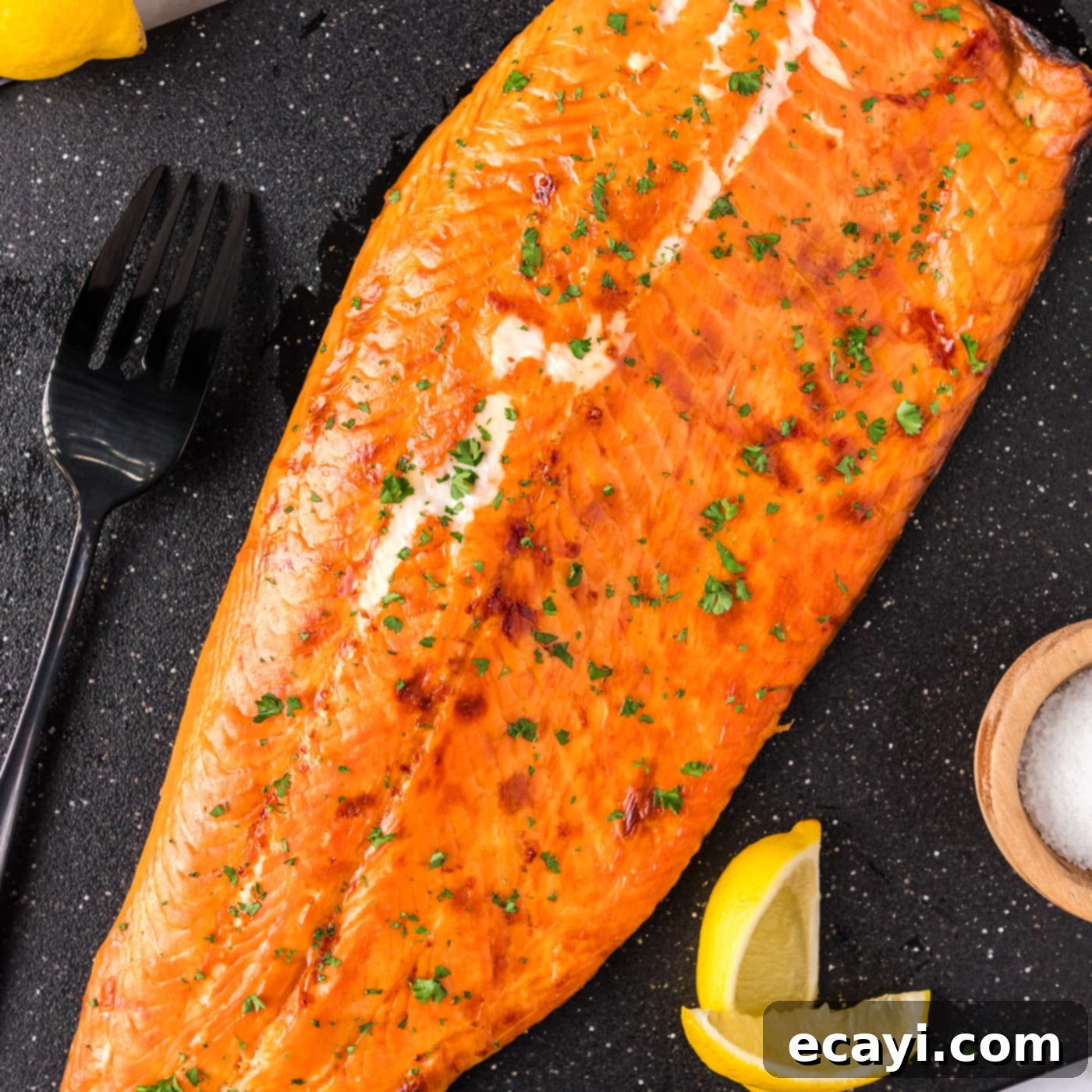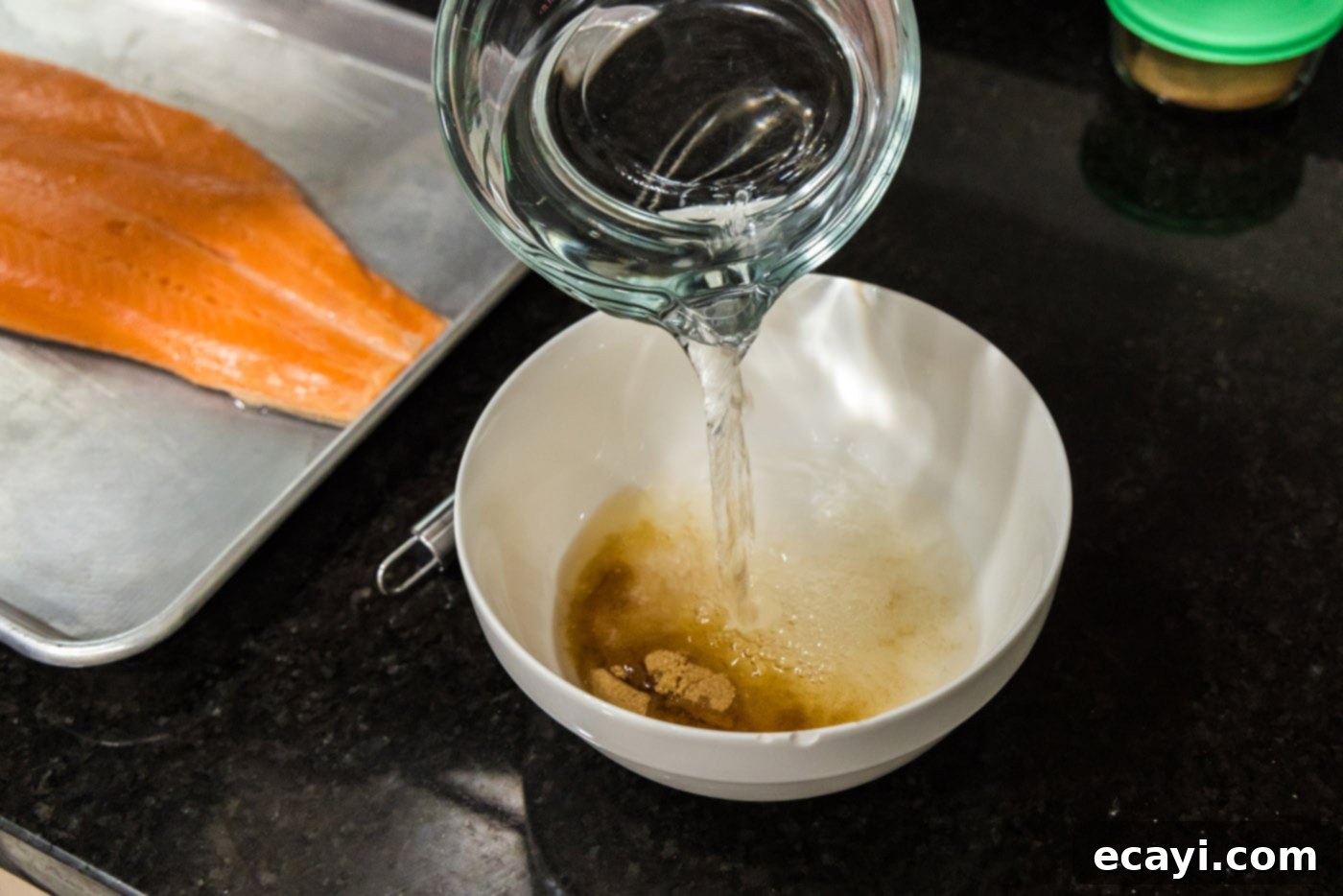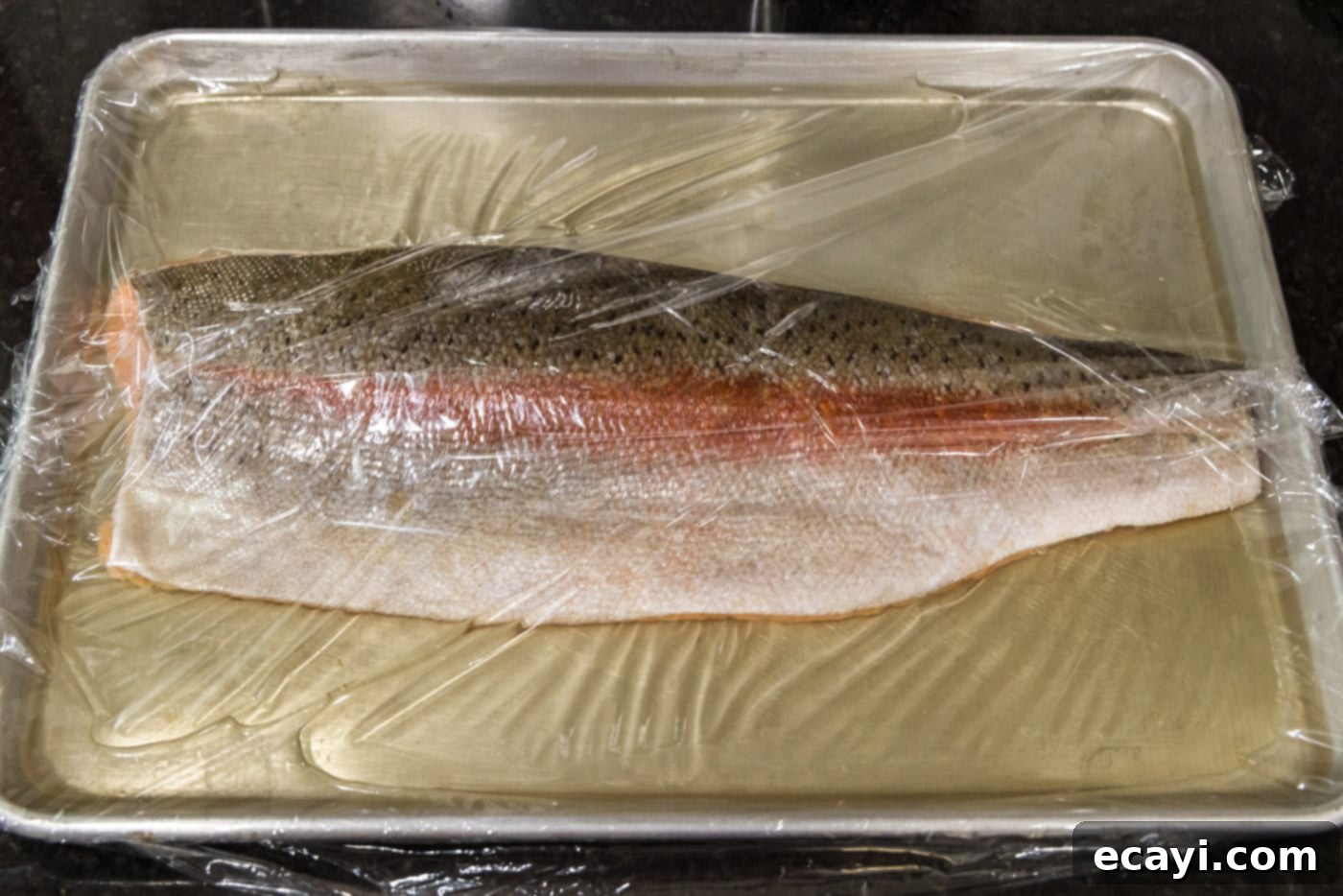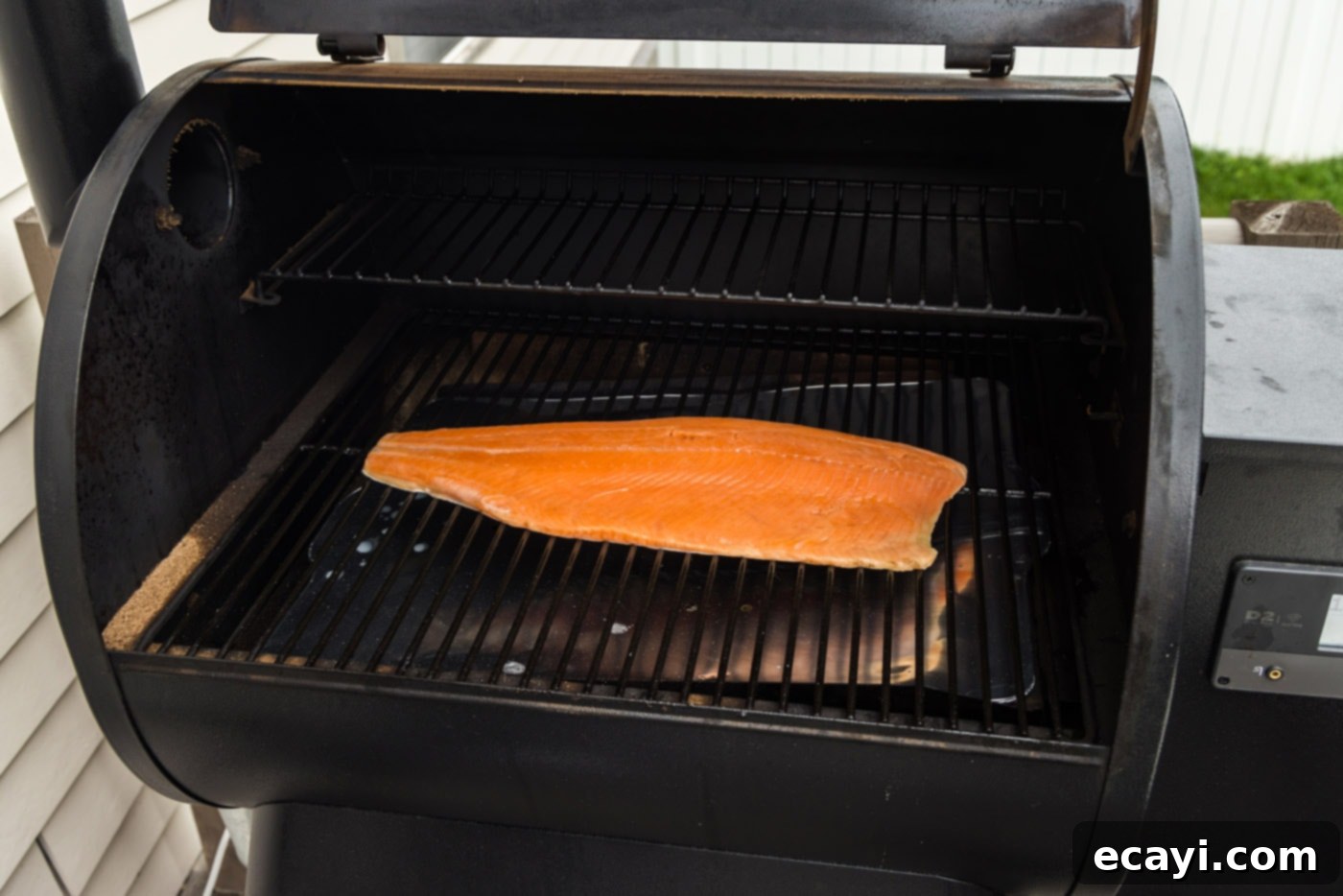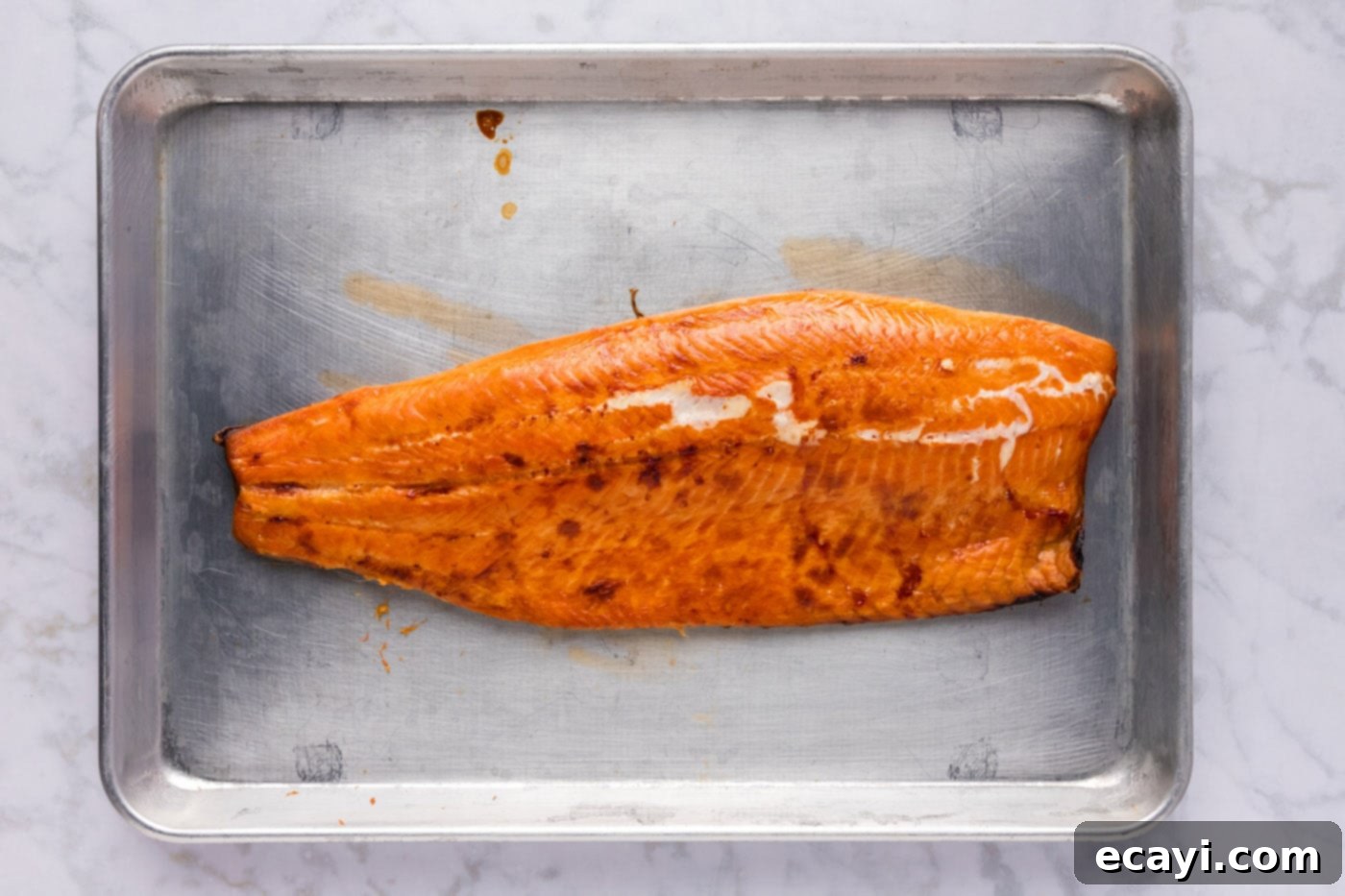Perfectly Smoked Trout: An Easy Guide to Flaky, Flavorful Fish
Unlock the secrets to perfectly flaky and buttery smoked trout with this incredibly easy recipe. Starting with a simple brine and finishing in the smoker, you’ll achieve the most tender, succulent results every time. Forget complicated cooking methods; this guide will show you how to smoke trout at home with minimal effort, transforming a fresh fish fillet into a gourmet delight. Whether you’re a seasoned pitmaster or a beginner, this straightforward approach guarantees a delicious outcome that’s rich in flavor and wonderfully moist.
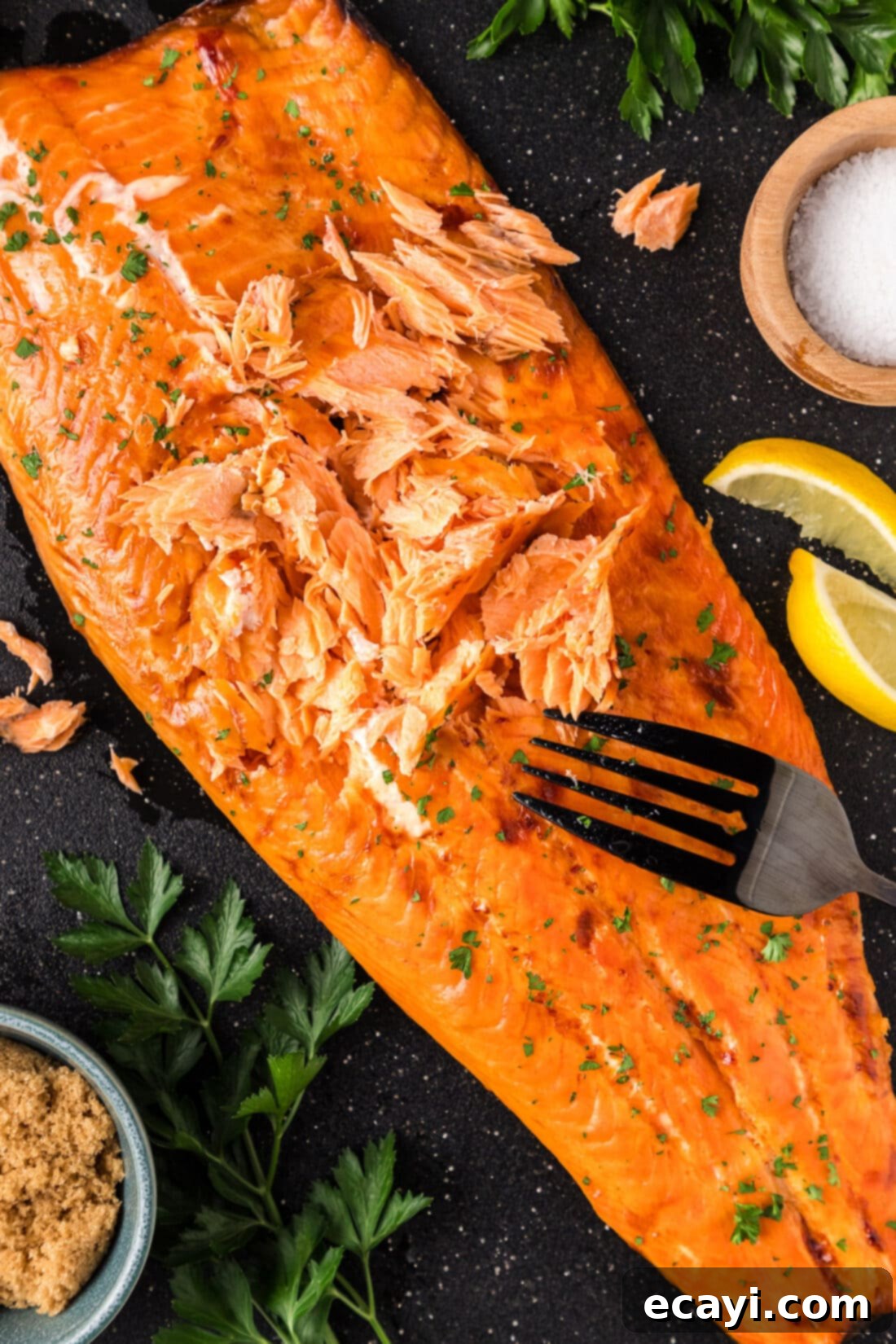
Why This Easy Smoked Trout Recipe Works Wonders
Smoking trout is a culinary art that, when simplified, yields extraordinary results. This recipe excels because it harnesses the power of a gentle smoking process combined with a foundational brine. Trout, particularly steelhead, offers a wonderfully neutral base, similar in texture to salmon but often with an even milder, less “fishy” flavor profile. This makes it an ideal canvas for the subtle, aromatic notes of wood smoke.
The beauty of slow smoking lies in its ability to gently cook the fish, preventing it from drying out while maintaining its natural moisture. As the heat permeates the trout, the connective tissues gradually break down, resulting in an incredibly tender, almost buttery texture that practically melts in your mouth. Unlike harsher cooking methods, smoking infuses the fish with a delicate flavor that complements its inherent richness without overpowering it. Our simple brine, a blend of brown sugar, salt, and water, plays a critical role in enhancing these natural flavors, adding depth, and ensuring the fish remains juicy throughout the smoking process. It’s a foolproof method that turns fresh trout into a delectable, flaky masterpiece, proving that gourmet smoked fish can be effortlessly achieved at home.
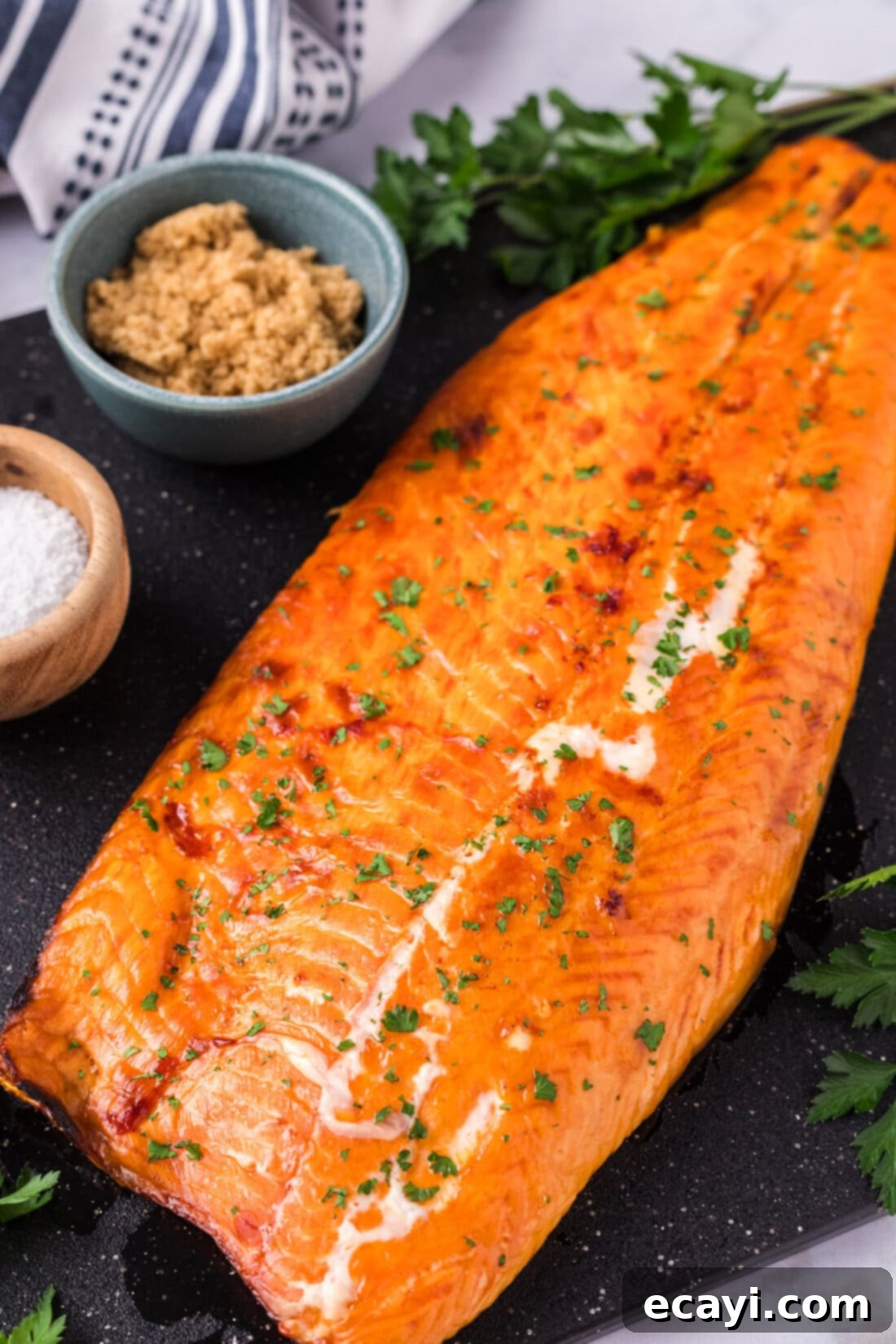
Essential Ingredients You Will Need for Smoked Trout
Crafting delicious smoked trout requires just a few key ingredients. The simplicity of this recipe allows the natural flavors of the fish and the subtle smokiness to truly shine. Before you begin, gather these staples:
- **Fresh Trout Fillets:** The star of our dish.
- **Water:** The base for our flavor-infusing brine.
- **Brown Sugar:** Adds a touch of sweetness and helps with caramelization and moisture retention.
- **Kosher Salt:** Essential for brining, enhancing flavor, and firming the fish’s texture.
You can find all precise measurements and detailed instructions in the printable recipe card located at the end of this comprehensive guide. This simple list ensures that even novice chefs can create an impressive smoked trout dish with ease.
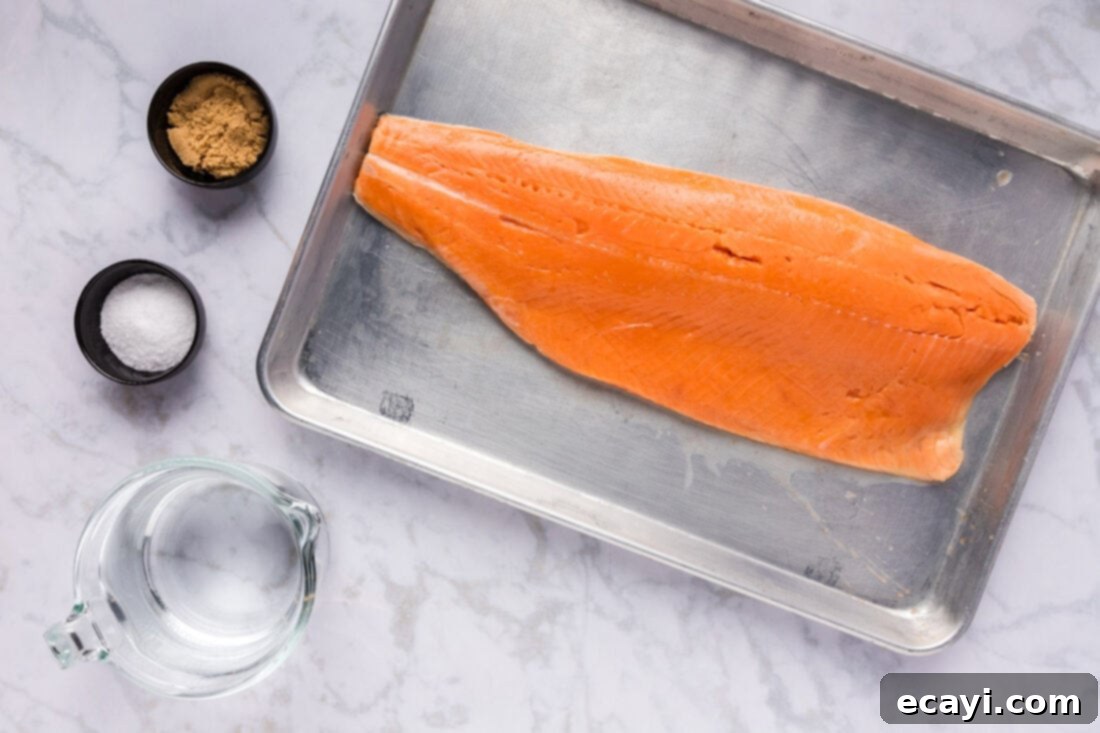
Ingredient Insights and Smart Substitution Suggestions
Understanding your ingredients is key to successful smoking. Here’s a closer look at what we’re using and how you can adapt the recipe:
- TROUT: For this recipe, we specifically recommend **steelhead trout**. Steelhead, an anadromous form of rainbow trout, is prized for its beautiful pink-orange flesh and a remarkably mild, almost non-fishy taste. It shares a similar rich, delicate texture with salmon, making it ideal for smoking as it remains incredibly moist and flaky. If steelhead is unavailable in your local market, **rainbow trout** is an excellent alternative. While rainbow trout might have a slightly stronger flavor than steelhead, it still smokes beautifully and will yield delicious results. When selecting your trout, look for bright, clear eyes (if purchasing a whole fish), firm flesh, and a fresh, clean smell. Opt for skin-on fillets, as the skin helps protect the fish from drying out during the smoking process and adds flavor.
- BROWN SUGAR: This ingredient does more than just add sweetness. Brown sugar contributes to the maillard reaction during smoking, helping to create a beautiful, slightly caramelized crust on the fish. It also aids in moisture retention, keeping the trout succulent. Both light and dark brown sugar work well; dark brown sugar will impart a slightly deeper molasses flavor. If you prefer a less sweet profile, you can slightly reduce the amount of brown sugar or even substitute a portion with maple syrup for a different nuanced sweetness.
- KOSHER SALT: Crucial for the brining process, Kosher salt not only seasons the fish but also helps to cure it, drawing out moisture and firming up the flesh, which improves the final texture. Do not substitute with table salt, as its finer granules can make the brine too salty. If you only have sea salt, use it sparingly as it can also be more potent than Kosher salt by volume.
- WATER: The base for our simple brine. Ensure it’s clean, potable water. You don’t need fancy filtered water, tap water is perfectly fine.
By paying attention to these simple details, you’ll ensure your smoked trout is nothing short of spectacular.
Step-by-Step Guide: How to Make Irresistible Smoked Trout
These step-by-step photos and instructions are here to help you visualize how to make this recipe. For a quick reference, you can Jump to Recipe to get the printable version of this recipe, complete with measurements and instructions at the bottom.
-
Prepare the Flavorful Brine
To make the brine, begin by combining brown sugar and Kosher salt in a small bowl. Gradually add water, stirring continuously until both the sugar and salt are completely dissolved. It’s important that the mixture is uniform to ensure even seasoning of your trout. This simple brine is the secret to infusing the fish with flavor and maintaining its moisture during smoking.

-
Pour Brine into a Suitable Pan
Carefully pour the dissolved brine into a large shallow pan.
PRO TIP – While a shallow pan can work, we highly recommend using a large baking pan with higher sides. This makes it much easier to handle the fish and move the pan without accidental spills. If your trout fillets are too long to fit comfortably in a single pan, feel free to cut them in half before brining to ensure they are fully submerged and evenly seasoned.
-
Brine the Trout
Gently place the fish fillets into the brine, ensuring the skin side is facing up. The fish should be mostly submerged in the brine. Cover the pan tightly with plastic wrap and transfer it to the refrigerator. Allow the trout to brine for 45 minutes. This relatively short brining time is sufficient to impart flavor and prepare the fish for smoking without making it overly salty.

-
Preheat Your Smoker
While the trout is brining, preheat your smoker to a consistent temperature of 180°F (82°C). Maintaining a low and steady temperature is crucial for smoking fish, as it ensures the fish cooks gently and absorbs plenty of smoke flavor without drying out. Prepare your chosen wood chips (such as apple, cherry, or alder) according to your smoker’s instructions.
-
Smoke the Trout to Perfection
Once the brining time is complete, remove the fish from the brine. Pat the fillets dry thoroughly with paper towels; this step is important for achieving a good smoke ring and preventing a rubbery texture. Place the fish fillets skin side down directly onto the grill grates of your preheated smoker. Close the lid and allow the trout to smoke for approximately 2 hours. During this time, the trout will absorb a beautiful smoky flavor and cook through to a flaky, tender consistency.

-
Optional: Add a Touch of Broiler Color
For those who prefer a little extra color and a slightly crispier top, you can finish the smoked trout under your oven’s broiler. After smoking, carefully transfer the fillets to a baking sheet. Place them under a preheated broiler for 3-5 minutes, watching closely to prevent burning. This step is entirely optional but can enhance the visual appeal and add another layer of texture.

Frequently Asked Questions & Expert Tips for Perfect Smoked Trout
Once your delicious smoked trout has fully cooled, transfer any leftovers to an airtight container. Store this in the refrigerator, where it will remain fresh and flavorful for up to 6 days. Proper storage is key to preserving its taste and texture.
Absolutely! Smoked trout freezes beautifully, allowing you to enjoy your efforts for longer. To freeze, ensure the trout is completely cooled. Wrap it tightly first in plastic wrap, then in aluminum foil, or place it in a freezer-safe container or a resealable freezer bag, removing as much air as possible. Label the package with the date, and freeze for up to 3 months. When you’re ready to enjoy it, thaw the smoked trout in the refrigerator overnight. Since smoked trout is fully cooked during the smoking process, reheating is not strictly necessary. However, if you prefer to serve it warm, reheat it gently in a low-temperature oven (around 250°F / 120°C) until just warmed through, adding a splash of water or a pat of butter to prevent it from drying out.
Additional Expert Tips for the Best Smoked Trout:
- Wood Chip Selection: The type of wood you use significantly impacts the flavor. For trout, milder fruit woods like **apple** or **cherry** are excellent choices, imparting a slightly sweet and fruity smoke. **Alder** wood is another classic choice for fish, offering a delicate, earthy flavor that complements the trout without overwhelming it. Avoid heavy, strong woods like mesquite, which can be too intense for fish.
- Maintain Consistent Smoker Temperature: The key to tender, moist smoked fish is a low and steady temperature. Fluctuations can lead to uneven cooking or dry fish. Invest in a good thermometer for your smoker to monitor the internal temperature accurately.
- Don’t Over-Brine: While brining is essential, over-brining can result in overly salty fish. Stick to the recommended 45 minutes for this recipe to ensure perfect flavor balance.
- Pat Dry for Better Texture: After brining, thoroughly patting the fish dry with paper towels is crucial. This step helps form a pellicle – a slightly tacky surface – which allows the smoke to adhere better, resulting in a more flavorful and visually appealing smoked fish. It also helps prevent a mushy texture.
- Monitor Internal Temperature: For food safety and optimal texture, the internal temperature of the smoked trout should reach 145°F (63°C). Use an instant-read thermometer inserted into the thickest part of the fillet to confirm doneness.
- Let it Rest: After smoking, allow the trout to rest for 5-10 minutes off the smoker before serving. This allows the juices to redistribute, ensuring maximum moisture and flavor.
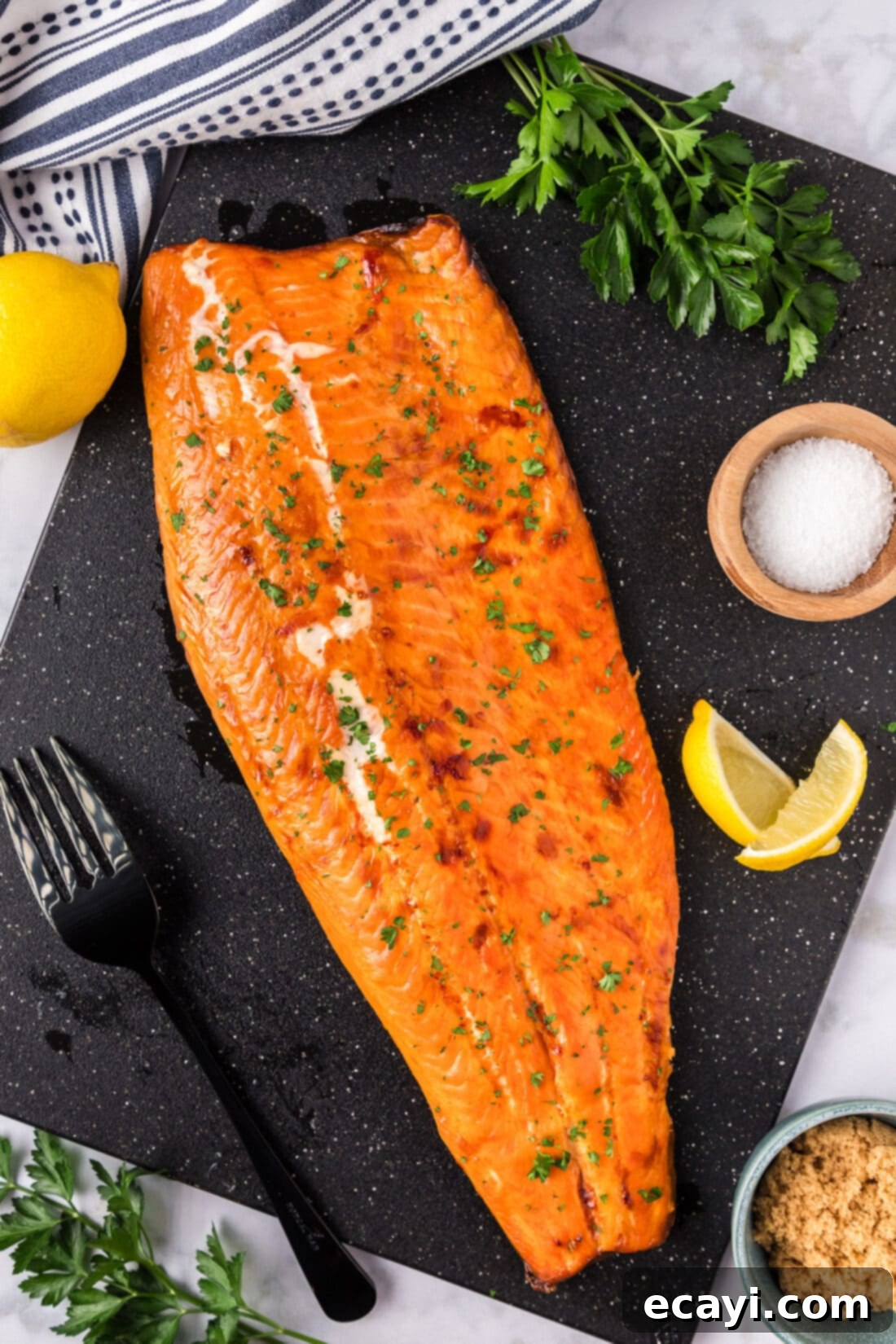
Creative Serving Suggestions for Smoked Trout
Once you’ve mastered this delicious smoked trout recipe, the culinary possibilities are endless! Its rich flavor and flaky texture make it incredibly versatile for a wide range of dishes. Here are some inspiring ways to serve and enjoy your homemade smoked trout:
- Standalone Delight: Enjoy it simply as is, perhaps with a squeeze of fresh lemon and a side of roasted asparagus or steamed green beans for a light yet satisfying meal.
- Elegant Appetizer: Flake the smoked trout and serve it on crackers, crostini, or cucumber slices with a dollop of cream cheese, capers, and fresh dill. It makes for an impressive party starter.
- Salad Booster: Add flaked smoked trout to a vibrant green salad, a hearty potato salad, or a protein-packed pasta salad for an extra layer of flavor and nutrition. It pairs wonderfully with a light vinaigrette.
- Flavorful Spreads and Dips: Follow our Crab Rangoon recipe and simply substitute the crab with your smoked trout to create an unforgettable Smoked Trout Rangoon. Alternatively, use it in place of salmon in a creamy smoked salmon dip, perfect for bagels or crudités.
- Breakfast & Brunch Brilliance: Incorporate smoked trout into omelets, scrambled eggs, or a savory quiche for a gourmet breakfast. It also shines on a toasted bagel with cream cheese, sliced red onion, and a sprinkle of everything bagel seasoning.
- Sandwiches & Wraps: Elevate your lunch by adding smoked trout to sandwiches, wraps, or even a sophisticated open-faced tartine. Pair it with avocado, arugula, and a touch of horseradish cream for an incredible flavor combination.
- Pasta Perfection: Toss flaked smoked trout with pasta, a light cream sauce, cherry tomatoes, and fresh herbs for a quick and elegant weeknight dinner.
From simple snacking to sophisticated meals, smoked trout is a versatile ingredient that elevates any dish. Experiment with these ideas and discover your favorite way to savor its unique taste!
Explore More Delicious Smoker Recipes
If you loved making this smoked trout, you’re in for a treat! The smoker is an incredibly versatile tool, capable of producing a wide array of mouth-watering dishes beyond just fish. Expanding your repertoire with other smoked delights can transform your outdoor cooking experience. Here are some of our other top-rated recipes that utilize the magic of the smoker:
- **Smoked Beef Ribs:** Fall-off-the-bone tender ribs with an incredible smoky bark.
- **Smoked Queso Dip:** A crowd-pleasing appetizer with a rich, smoky depth.
- **Smoked Ribeye Steak:** Achieve a perfectly cooked steak with a beautiful smoky crust.
- **Smoked Beef Short Ribs:** Tender, juicy short ribs infused with deep smoky flavor.
- **Smoked Salmon:** If you enjoyed the trout, you’ll love our equally delicious smoked salmon recipe!
Each of these recipes offers a unique way to experience the fantastic flavors that only a smoker can provide. Get ready to impress your friends and family with these delicious, smoky creations!
I love to bake and cook and share my kitchen experience with all of you! Remembering to come back each day can be tough, that’s why I offer a convenient newsletter every time a new recipe posts. Simply subscribe and start receiving your free daily recipes!
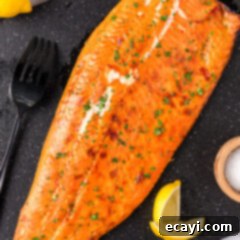
Perfectly Flaky Smoked Trout
IMPORTANT – There are often Frequently Asked Questions within the blog post that you may find helpful. Simply scroll back up to read them!
Print It
Pin It
Rate It
Save ItSaved!
Ingredients
- 2 pounds Steelhead trout fillets (skin on preferred)
- 1 cup water (for brine)
- 2 Tablespoons brown sugar
- 2 Tablespoons Kosher salt
Things You’ll Need
-
Large baking pan with high sides, or a brining container
-
Smoker (electric, pellet, or charcoal)
-
Instant-read thermometer
-
Plastic wrap
-
Paper towels
Before You Begin
- For easier handling and to prevent spills, we recommend using a large baking pan with higher sides for brining. If your trout fillets are long, cutting them in half ensures they fit and brine evenly.
- We prefer steelhead trout for its mild flavor and beautiful texture, similar to salmon but less “fishy.” If steelhead is not available, rainbow trout is an excellent substitute.
- Ensure your trout fillets are skin-on; the skin helps protect the fish from drying out during the smoking process and adds flavor.
Instructions
-
In a small bowl, thoroughly dissolve the brown sugar and Kosher salt in 1 cup of water to create your brine solution. Stir until no granules remain.
-
Pour the prepared brine into a large shallow pan or a baking dish with high sides, ensuring it’s wide enough to accommodate your trout fillets.
-
Place the trout fillets into the brine, skin side up. Make sure the fish is mostly submerged. Cover the pan with plastic wrap and refrigerate for exactly 45 minutes.
-
While the trout brines, preheat your smoker to a stable temperature of 180°F (82°C). Prepare your chosen wood chips (e.g., apple, cherry, alder) according to your smoker’s instructions.
-
After brining, remove the fish from the brine and pat it very dry with paper towels. Place the fillets skin side down directly onto the preheated smoker grill grates. Close the lid and smoke for approximately 2 hours, or until the internal temperature reaches 145°F (63°C) at the thickest part.
-
If you desire a more vibrant color on top of your smoked trout, you can transfer the fillets to a baking sheet and place them under your oven’s broiler for 3-5 minutes. Watch carefully to prevent burning.
Expert Tips & FAQs
- **Storage:** Store cooled leftover smoked trout in an airtight container in the refrigerator for up to 6 days for best freshness.
- **Freezing:** To freeze, wrap fully cooled trout tightly in plastic wrap, then aluminum foil, or place in a freezer-safe container/bag. Label with the date and freeze for up to 3 months. Thaw in the refrigerator overnight. Reheating is optional; if desired, do so gently in a low oven to prevent drying.
- **Wood Selection:** Use mild fruit woods like apple or cherry, or alder for a classic fish-smoking flavor. Avoid overpowering woods like mesquite.
- **Pellicle Formation:** Patting the fish dry after brining creates a tacky surface (pellicle) that helps smoke adhere and improves texture.
Nutrition Information
The recipes on this blog are tested with a conventional gas oven and gas stovetop. It’s important to note that some ovens, especially as they age, can cook and bake inconsistently. Using an inexpensive oven thermometer can assure you that your oven is truly heating to the proper temperature. If you use a toaster oven or countertop oven, please keep in mind that they may not distribute heat the same as a conventional full sized oven and you may need to adjust your cooking/baking times. In the case of recipes made with a pressure cooker, air fryer, slow cooker, or other appliance, a link to the appliances we use is listed within each respective recipe. For baking recipes where measurements are given by weight, please note that results may not be the same if cups are used instead, and we can’t guarantee success with that method.
